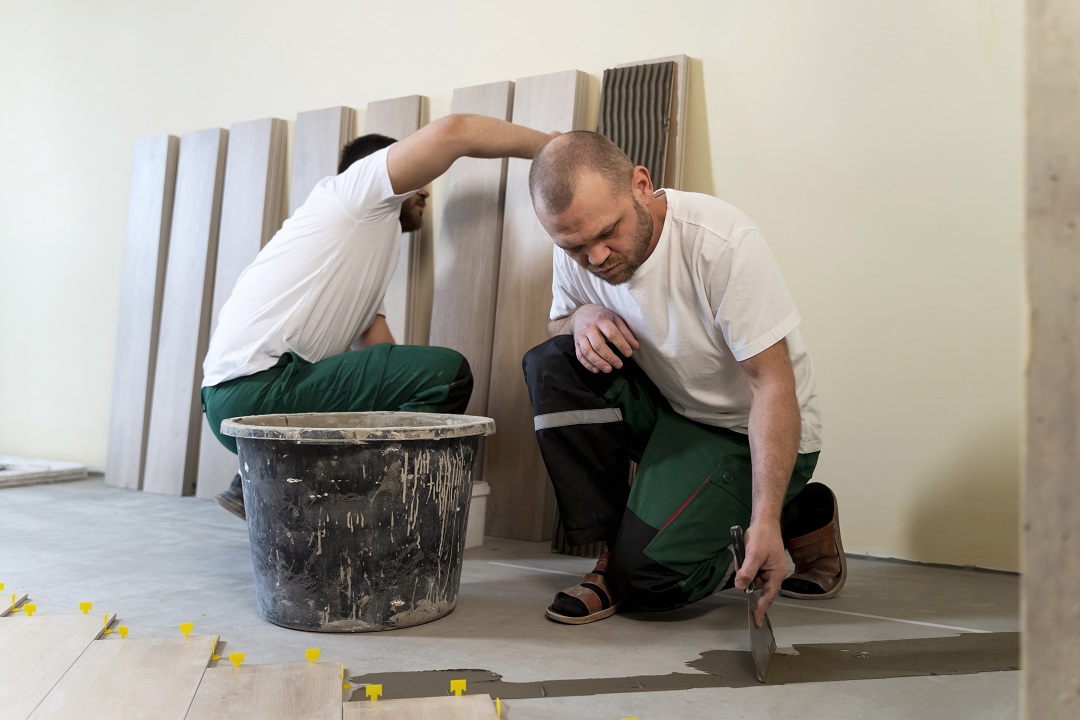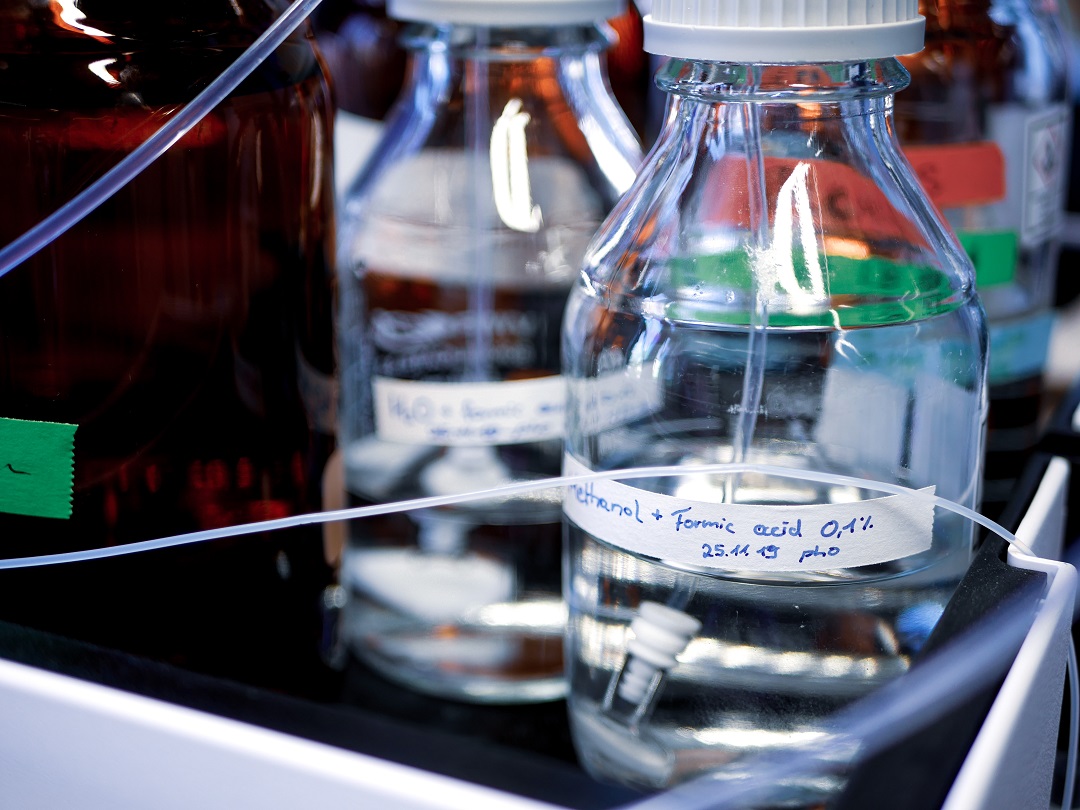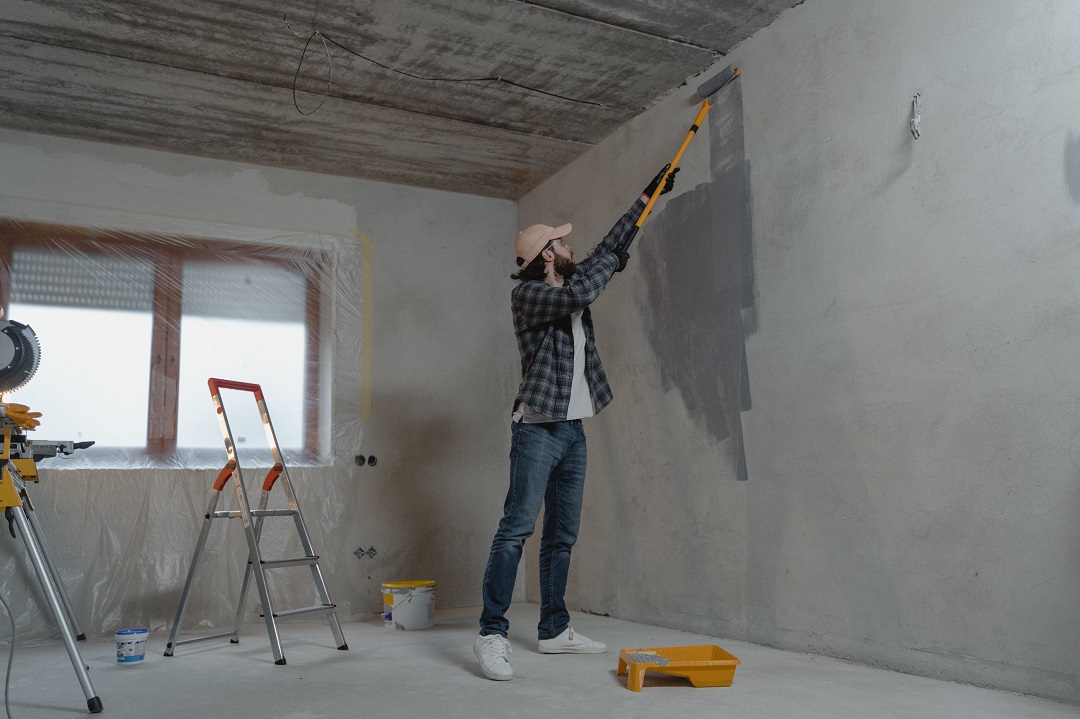Waterproofing
Water proofing mention to the process of making a structure or material impenetrable to the puncturing of water. It is commonly used in construction to protect buildings, infrastructure, and various surfaces from water damage.
There are several methods and products available for water-proofing, depending on the specific application and requirements. Here are some commonly used techniques:
Surface Treatments: Surface coatings or sealants can be applied to various materials like concrete, wood, or masonry to create a barrier against water. These coatings may be in the form of paints, epoxy resins, or polyurethane-based products.
Membrane Water-proofing: This method involves the application of waterproof membranes over surfaces such as roofs, basements, or foundations. Membranes can be made from various materials such as modified bitumen, PVC, EPDM (ethylene propylene diene monomer), or TPO (thermoplastic olefin).
Cementitious Water-proofing: This technique involves using cement-based products to create a waterproof barrier. Special additives are mixed with cement to improve its water-resistant properties. Cementitious water proofing is commonly used in basements, swimming pools, or water tanks.
Bentonite Water-proofing: Bentonite clay, when hydrated, swells to form an impermeable barrier. It is often used in below-grade water-proofing applications, such as retaining walls or underground structures. Bentonite can be applied as a sheet or as a slurry.
Injection Water-proofing: This method is employed to repair cracks or joints in concrete or masonry structures. Waterproofing materials, such as epoxy or polyurethane, are injected into the cracks to seal them and prevent water infiltration.
Drainage Systems: In some cases, water-proofing is complemented by the installation of drainage systems. These systems help manage water by collecting and redirecting it away from vulnerable areas, such as foundation walls or basements.
Water-proofing is essential to protect structures from water damage, as water infiltration can lead to structural deterioration, mold growth, and other related issues. It is important to consider the specific requirements of each application and consult with professionals to determine the most suitable water-proofing method and products to use.
Foundation Waterproofing
Foundation water proofing is the process of protecting a building’s foundation from water damage by applying various techniques and materials to prevent the infiltration of water. Water proofing is essential because water can cause significant damage to a foundation, leading to structural problems, mold growth, and other issues.
There are several methods used for foundation water-proofing, including:
Exterior Waterproofing: This method involves excavating the soil around the foundation and applying a waterproof membrane or coating to the exterior walls. It helps to prevent water from seeping into the foundation walls.
Interior Water-proofing: In this approach, water-proofing materials such as coatings, sealants, or membranes are applied to the interior walls of the foundation. It helps to manage water that enters the foundation and directs it away from the interior space.
Drainage Systems: Installing a drainage system is an important aspect of foundation water-proofing. It involves creating a network of pipes, drains, and sump pumps to collect and redirect water away from the foundation. This prevents water accumulation and potential damage.
Crawl Space Encapsulation: If your home has a crawl space, encapsulation can help waterproof the foundation. It involves sealing the crawl space with a vapor barrier, insulation, and a dehumidifier to control moisture levels.
Foundation Repair: Water-proofing may also involve repairing any existing cracks, gaps, or damaged areas in the foundation. This ensures that water cannot penetrate through these weak points.
It’s important to note that foundation water proofing is typically done during the construction or renovation of a building. However, in some cases, it can also be retrofitted to existing structures. It’s recommended to consult with a professional water proofing contractor who can assess your specific situation and provide the most appropriate solutions for your foundation water proofing needs.
Waterproofing in Bangladesh

Waterproofing is an important aspect of construction in Bangladesh, considering the country’s climate and geographical location. Bangladesh experiences heavy rainfall and is prone to flooding, making waterproofing measures crucial to protect buildings and infrastructure.
In Bangladesh, there are various methods and materials used for waterproofing. Some commonly employed techniques include:
Bituminous Membrane: This method involves applying a layer of bitumen-based material, often reinforced with a fabric or fiberglass mat, to create a waterproof barrier. Bituminous membranes are commonly used for flat roofs, basements, and foundations.
Polyurethane Coatings: Polyurethane coatings provide a seamless and flexible water proofing solution. They are often applied as liquid membranes that form a durable barrier when cured. Polyurethane coatings are commonly used on roofs, balconies, and concrete surfaces.
Cementitious Water proofing: This method involves the application of cement-based coatings or membranes to provide a waterproof barrier. Cementitious coatings are typically used for concrete structures, such as water tanks, swimming pools, and basements.
Liquid Applied Membranes: Liquid-applied membranes are coatings that can be sprayed or roller-applied to form a continuous waterproof layer. These membranes can be made of various materials, such as acrylics, polyurethanes, or modified bitumen. They are commonly used for roofs, terraces, and foundations.
Injection Waterproofing: Injection waterproofing is often used to repair and seal cracks in concrete structures. Waterproofing material is injected into the cracks to fill and seal them, preventing the passage of water.
It is important to consult with water proofing experts or professionals to assess the specific requirements of each project and determine the most suitable water proofing method and materials. Local building codes and regulations should also be considered to ensure compliance and effectiveness in the Bangladesh context.
Waterproofing membrane

A waterproofing membrane is a material or system used to prevent the ingress of water into a structure or building. It is typically applied to areas that are prone to water exposure, such as basements, roofs, balconies, and bathrooms. The membrane forms a barrier that prevents water from penetrating through the surface and causing damage to the underlying structure.
There are various types of waterproofing membranes available, each with its own characteristics and applications. Some common types include:
Bituminous Membranes: These are made from modified bitumen or asphalt and are commonly used in below-grade applications. They are strong, bendable, and can withstand high warmth.
Sheet Membranes: Sheet membranes are typically made from materials like PVC, EPDM, or TPO (thermoplastic olefin). They come in large rolls and are applied to the surface using adhesives, heat, or mechanical fasteners.
Liquid Membranes: Liquid membranes are applied in a liquid form and then cure to form a seamless, waterproof barrier. They are often used in areas with complex shapes or irregular surfaces.
Cementitious Membranes: Cementitious membranes are composed of cement, sand, and polymers. They are mixed with water and applied as a slurry to form a protective layer that is resistant to water penetration.
Rubberized Asphalt Membranes: These membranes are made from a combination of asphalt and rubber polymers. They offer excellent flexibility and are commonly used in roofing applications.
The choice of water proofing membrane depends on various factors such as the location, type of structure, expected water exposure, and budget. It is important to select a membrane that is appropriate for the specific requirements of the project and to follow the manufacturer’s guidelines for installation to ensure its effectiveness.
Roof waterproofing
Roof waterproofing is a process of applying protective coatings or materials to a roof surface to prevent water infiltration and damage. It is an essential step in building maintenance and construction to ensure the longevity and integrity of the roof.
There are several methods and materials used for roof waterproofing, depending on the type of roof and specific requirements. Here are some common techniques:
Membrane Waterproofing: This method involves applying a waterproof membrane, typically made of bitumen, PVC, TPO, or EPDM, directly onto the roof surface. The membrane forms a barrier against water penetration and provides long-lasting protection.
Liquid Waterproofing: Liquid waterproofing systems involve applying a liquid coating or sealant to the roof surface. These coatings usually consist of polymer-based materials, such as acrylic, polyurethane, or silicone. They are sprayed, rolled, or brushed onto the roof, forming a seamless and flexible membrane that seals out water.
Cementitious Waterproofing: This method uses a cement-based coating or slurry to waterproof the roof. The cementitious material is applied in multiple layers, forming a rigid and durable barrier against water. It is commonly used for flat roofs and concrete structures.
Sheet Waterproofing: Sheet membranes, such as asphalt-impregnated felt or modified bitumen sheets, can be applied to the roof surface for waterproofing. The sheets are overlapped and adhered to create a continuous waterproof barrier. Sheet waterproofing is often used in conjunction with other methods for enhanced protection.
Green Roof Waterproofing: In green roof systems, a waterproofing layer is installed beneath the vegetation and growing medium. This layer prevents water from reaching the underlying structure while allowing for drainage. Green roofs provide environmental benefits and can help reduce stormwater runoff.
It’s important to note that roof waterproofing should be carried out by professionals with expertise in the specific technique and materials being used. Proper preparation, surface cleaning, and application techniques are crucial for effective and long-lasting waterproofing results. Regular inspection and maintenance are also recommended to identify and address any potential issues before they cause significant damage.
Basement waterproofing
Basement waterproofing is the process of preventing water from entering and damaging the basement of a building. It is an important step in maintaining the structural integrity of a building and protecting it from moisture-related issues such as mold, mildew, and water damage.
There are several methods and techniques used for basement waterproofing, depending on the specific needs and characteristics of the building. Here are some common approaches:
Exterior Waterproofing: This method involves excavating the soil around the foundation to expose the exterior walls of the basement. The walls are then cleaned, repaired, and coated with a water-proofing membrane. A drainage system is installed to redirect water away from the foundation.
Interior Waterproofing: In this approach, the basement is waterproofed from the inside. It typically involves installing a water-proofing membrane or coating on the interior walls and floors to create a barrier against moisture. Interior drainage systems, such as French drains or sump pumps, may also be installed to collect and remove water that enters the basement.
Injection Waterproofing: This technique is used to repair cracks in the basement walls. It involves injecting a specialized waterproofing material into the cracks to seal them and prevent water from seeping through.
Drainage Systems: Installing proper drainage systems is crucial for basement water-proofing. It helps manage groundwater and surface water around the foundation. French drains, footing drains, and sump pump systems are commonly used to collect and redirect water away from the basement.
Grading and Landscaping: Ensuring proper grading and landscaping around the foundation can help prevent water from pooling near the basement walls. The ground should slope away from the building, and downspouts should be directed away from the foundation.
It is important to note that basement water-proofing is best performed by professionals with expertise in this field. They can assess the specific conditions of your basement and recommend the most appropriate water-proofing solutions.
Waterproofing chemicals

Waterproofing chemicals are substances or compounds used to make various materials resistant to the penetration of water or moisture. They are commonly used in construction, manufacturing, and other industries to protect structures, surfaces, and products from water damage. Below are a few typical varieties of waterproofing chemicals:
Bitumen: Bitumen is a black, tar-like substance derived from crude oil. It is commonly used in water-proofing applications, such as roof membranes and asphalt-based water-proofing coatings.
Polyurethane: Polyurethane-based water-proofing coatings are widely used for waterproofing concrete structures, roofs, and basements. They form a durable and flexible barrier against water penetration.
Acrylic: Acrylic-based water-proofing coatings are often used for applications like roof coatings, concrete sealers, and surface water-proofing. They provide good UV resistance and are easy to apply.
Silicone: Silicone water-proofing compounds are known for their excellent flexibility and resistance to weathering. They are commonly used in sealants, caulks, and coatings for various surfaces.
Cementitious: Cementitious water-proofing materials are based on cement or cement-like compounds. They are typically used for waterproofing basements, tunnels, and foundations.
Bentonite: Bentonite is a natural clay material that swells when it comes into contact with water. It is often used as an active water-proofing agent in systems like bentonite sheets or panels.
Epoxy: Epoxy-based coatings and sealants are widely used for water-proofing concrete, metal, and other surfaces. They provide a durable and chemical-resistant water-proofing barrier.
Rubberized asphalt: Rubberized asphalt waterp-roofing membranes consist of asphalt modified with rubber or polymer additives. They are commonly used in below-grade applications, such as foundation walls and tunnels.
PVC (Polyvinyl chloride): PVC water-proofing membranes are thermoplastic sheets that are heat-welded together to form a watertight barrier. They are often used in roofing and below-grade applications.
It’s important to note that the selection of the appropriate water-proofing chemical depends on factors such as the application, substrate, environmental conditions, and desired level of water-proofing. Consulting with a professional or manufacturer is recommended to determine the best water-proofing solution for a specific project.
Waterproofing chemical in Bangladesh
In Bangladesh, there are various waterproofing chemicals available in the market. These chemicals are used to protect buildings, roofs, basements, and other structures from water damage. Some commonly used waterproofing chemicals in Bangladesh include:
Bitumen: Bitumen is a common waterproofing material used in Bangladesh. It is a sticky, black, and viscous liquid or semi-solid form of petroleum. Bitumen is often used for waterproofing roofs, basements, and foundations.
Acrylic-based waterproofing coatings: Acrylic-based coatings are popular for waterproofing in Bangladesh. These coatings are typically applied as a liquid and form a flexible and durable membrane upon drying. They provide excellent water-proofing and weather resistance.
Polyurethane coatings: Polyurethane coatings are commonly used for water-proofing roofs, concrete surfaces, and balconies. These coatings provide excellent water-proofing properties, resistance to UV rays, and durability.
Cementitious coatings: Cementitious water-proofing coatings are composed of cement, sand, and various additives. These coatings are applied as a slurry and form a rigid, waterproof layer when cured. They are commonly used for basement waterproofing and for protecting concrete structures.
Liquid-applied membranes: Liquid-applied membranes are used for water-proofing roofs, terraces, and concrete structures. These membranes are typically made of a combination of polymers and additives, providing excellent water-proofing properties.
When considering water-proofing options, it’s important to consult with a professional waterp-roofing contractor or supplier in Bangladesh. They can assess your specific requirements and recommend the most suitable water-proofing chemical for your project. Additionally, always follow the manufacturer’s instructions and guidelines for proper application and safety precautions.
Cement waterproofing
Cement waterproofing refers to the process of making cement or concrete structures resistant to water penetration. It involves applying various products or techniques to enhance the water-proofing properties of cement-based materials, preventing water damage, moisture intrusion, and other related problems.
Here are some common methods and products used for cement water-proofing:
Waterproofing admixtures: These are chemical additives that are mixed with the cement during the mixing process. They modify the properties of the cement, making it more resistant to water penetration. Admixtures can reduce the size of capillary pores, increase the density of the concrete, and improve its overall waterproofing capabilities.
Surface coatings: Waterproof coatings are applied to the surface of cured concrete to create a barrier against water. These coatings can be in the form of liquid membranes, bituminous coatings, or elastomeric coatings. They provide a protective layer that prevents water from seeping into the concrete structure.
Cementitious waterproofing: This method involves applying a cement-based water-proofing compound directly to the surface of the concrete. The compound fills in the pores and capillaries of the concrete, reducing its permeability and enhancing its waterproofing properties.
Integral waterproofing systems: These are pre-mixed water-proofing compounds that are added to the concrete mixture before pouring. These additives disperse uniformly throughout the concrete, creating a waterproof barrier throughout the structure.
Injection grouting: This technique is used to repair existing cracks or voids in concrete structures. Waterproofing material is injected into the cracks, filling them and preventing water from seeping through.
Proper construction practices: Waterproofing can also be achieved through good construction practices. This includes ensuring proper compaction of the concrete, adequate curing, and proper placement of joints and waterproofing membranes during construction.
It’s important to note that while these methods can significantly improve the water-proofing properties of cement-based materials, no system is entirely foolproof. Regular maintenance and inspections are still necessary to ensure the long-term durability and effectiveness of water-proofing systems. Consulting with a professional or a specialized contractor is recommended for specific project requirements and guidance.
Waterproofing solutions
Cement waterproofing refers to the process of making cement or concrete structures resistant to water penetration. It involves applying various products or techniques to enhance the water-proofing properties of cement-based materials, preventing water damage, moisture intrusion, and other related problems.
Here are some common methods and products used for cement water-proofing:
Waterproofing admixtures: These are chemical additives that are mixed with the cement during the mixing process. They modify the properties of the cement, making it more resistant to water penetration. Admixtures can reduce the size of capillary pores, increase the density of the concrete, and improve its overall water-proofing capabilities.
Surface coatings: Waterproof coatings are applied to the surface of cured concrete to create a barrier against water. These coatings can be in the form of liquid membranes, bituminous coatings, or elastomeric coatings. They provide a protective layer that prevents water from seeping into the concrete structure.
Cementitious waterproofing: This method involves applying a cement-based water-proofing compound directly to the surface of the concrete. The compound fills in the pores and capillaries of the concrete, reducing its permeability and enhancing its waterproofing properties.
Integral waterproofing systems: These are pre-mixed water-proofing compounds that are added to the concrete mixture before pouring. These additives disperse uniformly throughout the concrete, creating a waterproof barrier throughout the structure.
Injection grouting: This technique is used to repair existing cracks or voids in concrete structures. Water-proofing material is injected into the cracks, filling them and preventing water from seeping through.
Proper construction practices: Waterproofing can also be achieved through good construction practices. This includes ensuring proper compaction of the concrete, adequate curing, and proper placement of joints and water-proofing membranes during construction.
It’s important to note that while these methods can significantly improve the water-proofing properties of cement-based materials, no system is entirely foolproof. Regular maintenance and inspections are still necessary to ensure the long-term durability and effectiveness of water-proofing systems. Consulting with a professional or a specialized contractor is recommended for specific project requirements and guidance.
Waterproofing admixture
Waterproofing admixture is a type of chemical additive used in construction materials, such as concrete, to enhance their resistance to water penetration. It is typically added during the mixing process to provide water-proofing properties to the final product.
Waterproofing admixtures work by reducing the pore size in concrete or other building materials, making them less permeable to water. They also create a hydrophobic barrier that repels water, preventing it from seeping through the material.
There are different types of water-proofing admixtures available, including:
Hydrophobic Admixtures: These admixtures contain water-repellent chemicals that form a barrier against water. They work by reducing the surface tension of water, making it unable to penetrate the material.
Crystalline Admixtures: These admixtures contain chemicals that react with moisture and free lime present in the concrete to form insoluble crystals. These crystals occupy the capillary pores and tiny cracks in the concrete, efficiently obstructing the movement of water.
Integral Water-proofing Admixtures: These admixtures are added directly to the concrete mix during batching. They improve the overall water resistance of the concrete, making it less porous and more durable against water penetration.
Benefits of using water-proofing admixtures include:
Enhanced Durability: Waterproofing admixtures help protect the structure from water damage, including cracking, spalling, and corrosion of embedded steel.
Reduced Maintenance: By preventing water ingress, water-proofing admixtures can reduce the need for repairs and maintenance, saving time and money in the long run.
Improved Structural Integrity: Water penetration can weaken the structure over time. Water-proofing admixtures help maintain the structural integrity of the building by preventing moisture-related damage.
It’s important to note that while water-proofing admixtures provide additional protection against water, they do not make the concrete or other materials completely impervious to water. Proper design, construction techniques, and additional water-proofing measures are also necessary for effective water management in a structure.
Roof waterproofing Bangladesh
Roof waterproofing is an essential process to protect buildings from water damage and leaks. In Bangladesh, where heavy monsoon rains are common, water-proofing the roof becomes even more crucial. There are various methods and materials available for roof waterproofing in Bangladesh. Here are a few commonly used techniques:
Bituminous Membrane Waterproofing: Bituminous membranes are widely used for roof waterproofing in Bangladesh. These membranes are made of modified bitumen and reinforced with polyester or fiberglass. They are applied in multiple layers to create a waterproof barrier on the roof.
Cementitious Waterproofing: Cementitious waterproofing involves the application of a cement-based coating or slurry to the roof surface. This coating forms a protective layer that prevents water penetration. It is commonly used for concrete roofs and can be reinforced with additives for added durability.
Liquid Applied Membrane Waterproofing: Liquid-applied membranes are fluid coatings that are applied directly to the roof surface. They form a seamless, flexible, and waterproof barrier when cured. These membranes are often used for irregular roof shapes or areas where other methods are not suitable.
Polyurethane Waterproofing: Polyurethane coatings are widely used for roof waterproofing due to their excellent flexibility, durability, and resistance to UV radiation. They are applied as liquid coatings that cure into a seamless and waterproof membrane.
PVC Membrane Waterproofing: PVC (Polyvinyl Chloride) membranes are synthetic materials that are highly resistant to water and UV radiation. These membranes are installed in a single-ply system, providing excellent waterproofing for flat or low-slope roofs.
When considering roof waterproofing in Bangladesh, it is important to consult with a professional waterproofing contractor who can assess your specific requirements and recommend the most suitable method for your roof. They will consider factors such as roof type, condition, budget, and the local climate to provide an effective water-proofing solution.
Wall waterproofing

Wall waterproofing is a process of treating walls or surfaces to make them resistant to water penetration. It is commonly done to protect buildings and structures from moisture damage, such as leaks, seepage, or dampness. Water-proofing is particularly important for areas that are exposed to water, such as basements, bathrooms, foundations, and exterior walls.
There are various methods and products available for wall waterproofing, depending on the specific needs and conditions of the structure. Here are some common techniques:
Waterproofing membranes: These are thin layers of waterproof material that are applied directly to the wall surface. They can be in the form of sheets, liquid coatings, or spray-applied membranes. These membranes create a barrier that prevents water from seeping through the walls.
Cementitious waterproofing: This method involves applying a cement-based coating or slurry to the wall surface. The cementitious material forms a protective layer that can withstand hydrostatic pressure and prevent water penetration.
Crystalline waterproofing: This technique involves applying a crystalline compound to the surface of the wall. The compound penetrates the concrete or masonry and forms crystals that fill the capillary pores, effectively blocking water from entering.
Exterior waterproofing: This approach focuses on preventing water from reaching the wall surface by installing drainage systems, such as waterproof membranes, weeping tiles, or French drains, around the exterior of the building. This method is commonly used in below-grade structures, such as basements.
Interior waterproofing: This method involves treating the interior side of the walls to prevent water from entering the living spaces. It may include the use of waterproof coatings, sealants, or installing drainage systems inside the wall assembly.
It’s important to note that the choice of this method depends on factors such as the type of wall material, the severity of the water problem, and the specific requirements of the structure. For best results, it is recommended to consult with a professional waterproofing contractor who can assess the situation and provide appropriate solutions.
